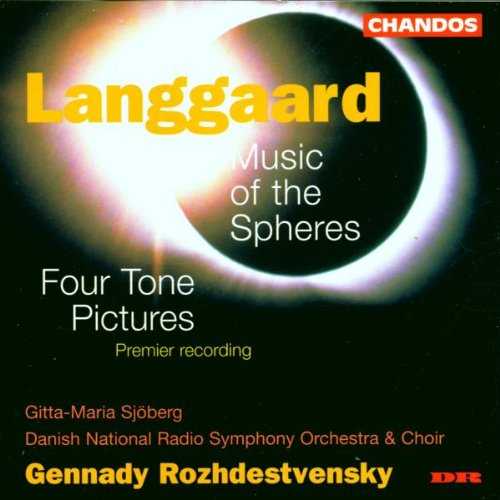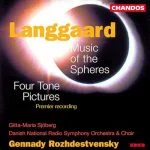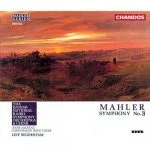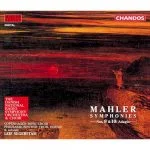
Composer: Rued Langgaard
Performer: Gitta-Maria Sjöberg
Orchestra: Danish National Radio Choir, Danish National Radio Symphony Orchestra
Conductor: Gennadi Rozhdestvensky
Audio CD
Number of Discs: 1
Format: FLAC (tracks)
Label: Chandos
Size: 226 MB
Recovery: +3%
Scan: yes
Staerernes musik (Music of the Spheres), BVN 128
01. I. Like sunbeams on a coffin decorated with sweet smelling flowers
02. II. Like the twinkling of stars in the blue sky at sunset
03. III. Like light and the depths
04. IV. Like the refraction of sunbeams in the waves
05. V. Like the twinkling of a pearl of dew in the sun on a beautiful summer’s morning
06. VI. Longing – Despair – Ecstasy
07. VII. Soul of the world – Abyss – All Soul’s day
08. VIII. I Wish ?!
09. IX. Chaos – Ruin – Far and near
10. X. Flowers wither
11. XI. Glimpse of the sun through tears
12. XII. Bells pealing: Look! He comes
13. XIII. The Gospel Of Flowers – From The Far Distance
14. XIV. The new day
15. XV. The end: Antichrist – Christ
4 Tone Pictures
16. No. 1. Likewords for a summer’s day saga
17. No. 2. A scent of mull and mud
18. No. 3. A golden flake hovers above
19. No. 4. The flowering summer was linked to the harvest
Exhilarating, Often Mindblowing Fun!
This was another recommendation to broaden my musical horizons. I won’t dwell on 20th century Danish composer Rued Langgaard’s supposed bitterness toward his lifetime lack of renown and the success of his contemporary Carl Nielsen, only that it’s an interesting footnote for the modern listener. I will say that Langgaard’s Music of the Spheres from 1918 is an incredibly exhilarating indulgence, redolent of those “celestial” musical qualities one would think of being more akin to the post-WWII period and not necessarily The Great War — one is immediately reminded of Ligeti’s similar musical utterances of nearly fifty years hence, moreso than anything from Holst’s The Planets. In fact, the CD notes by Bendt Viinholt Nielsen do bring up how Ligeti, upon first viewing the score while serving on a jury in 1968, openly stated how his and Langgaard’s compositional techniques were so similar as to suggest that he might be a Langgaard imitator! We hear otherworldly tone clusters, predominately from the high strings and winds, as well as a colorful plethora of orchestral sounds from brass to organ to bells, often accented and offset by the omnipresent tympani. One can’t help but think that Langgaard, in composing this work, was thinking well ahead of his time.
Toward the latter third of the roughly thirty-five minute work, whose many brief parts are given fanciful titles such as “Like Sunbeams on a Coffin Decorated with Sweet-Smelling Flowers”, is the appearance of near nonsensical vocals from soprano and then chorus melodically repeating “Do re mi fa sol la-a!” as if we’re being treated to a Freudian glimpse at composer’s block. (Ever see Jack Nicholson at the typewriter in The Shining?) After a romantically tinged bit from the soprano, beautifully sung, the work ends with an exciting and colorful orchestral and choral apocalypse! One is hard-pressed to decipher an intelligible program in all this; however, I like how it’s described in the notes as “a singular musical concept in which sound and space are in focus on behalf of a logical or organic form”…whatever in the cosmos THAT may mean! In any case, as I stated earlier, it’s an indulgence, but it’s still exhilarating and often mindblowing fun!
The Four Tone Pictures, dating from around the same period, are songs for soprano and orchestra which come from a different, more earthbound Late Romantic compositional realm, expressively sung by Sjöberg. They each carry titles and lyrics summoning nature and are thoroughly delightful. The entire CD is rendered in Chandos’ finest, most vivid recorded sound.
Enthralling Spatial Episodes & A Romantic Song Cycle
An amazing album. To sum up “Music of the Spheres,” I will quote the notes that come with the CD: “Langgaard’s work focuses on space, height and depth, light and shadow, foreground and background. It does not constitute musical process, but a succession of spatial episodes most often of a repetitive static nature. Or, as the composer himself expresses it, ‘In Music of the Spheres I have completely given up everything one understands by themes, consistency, form and continuity. It is music veiled in black and impenetrable mists of death.'” Although a work foreshadowing modernism, it has religious aspirations and is mostly meditative but sometimes enthralling. The other piece, Four Tone Pictures, is a more conventional and lush Romantic song cyclic.
Remarkable
Rued Langgaard (1893-1952) was a musical maverick if there ever was one. Much of his (especially later) music is deliberately derivative, some of it never venturing beyond Schumann’s style and deliberately lapsing into banality. Some of it, however, and in particular Sfærernes musik given here, is as visionary as any music composed by anyone at the time. Langgaard was never part of the musical mainstream (he had a particular aversion toward Carl Nielsen), but has certainly entered it the last couple of years, with all of his symphonies and in fact the main bulk of his output now available on disc, often in several recordings.
In any case, the Music of the Spheres is certainly the place to start exploring his music. Composed in 1916-18, it is essentially a late romantic work taking more than a cue from Richard Strauss and the European fin-de-siecle style of the time; but the result sounds like nothing else. In this mystically romantic framework Langgaard deploys experimental techniques, such as tone-clusters, not heard afterwards before the sixties (Ligeti, in particular) to create a sonic spectacular with aural effects not resembling anything else at all, and yet the result is a remarkably attractive, intimate and compelling work. There are plenty of remarkable scoring and textural effects; the music is buzzing, slithering, passionate, surging upwards in inverted maelstroms of sound, generating remarkable ornaments, creating echoes with off-stage instrumental groups, rich, Mahlerian and radiant. Interestingly, however, the instrumentation stays clear and uncluttered (the voices are used sparingly). But there is no use trying to describe the effects; it really has to be heard.
The Four Tone Pictures, a song-cycle for soprano and orchestra, are more conventional but wonderfully lush, otherworldly and mysteriously late-romantic and atmospheric with a lavish, almost hazy scoring. They are very well sung by Gitta-Maria Sjöberg, and the orchestra is on top form throughout – that also goes for the main work. The Danish National Radio SO under Gennadi Rozhdestvensky has clearly taking their time to ponder and prepare this unusual music, and the results are stunningly played and convincingly interpreted. The sound is warm and clear. I do not know the alternative performances, but in some version or other this is music you just have to hear.




Now if this isn’t a discovery. Blown away. Thanks a lot, whatever!
Thanks.
This is interesting music. Hard to believe it was written in 1916. Thank you for something completely new to me, Mr Whatever!
Thank you!
;)